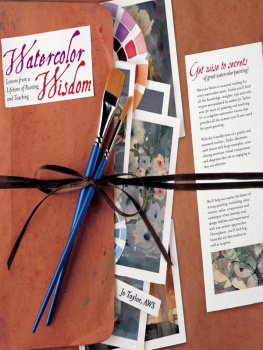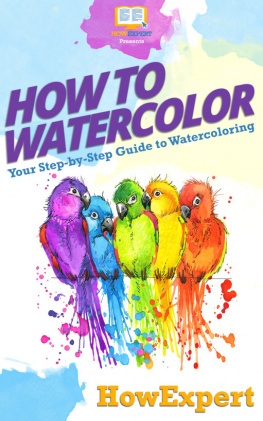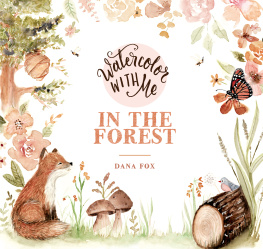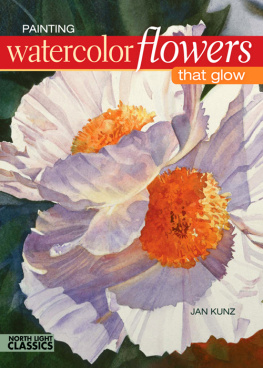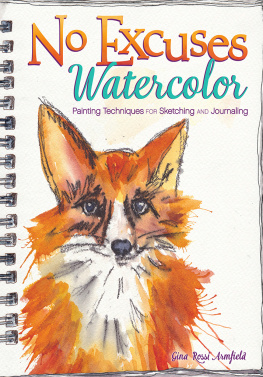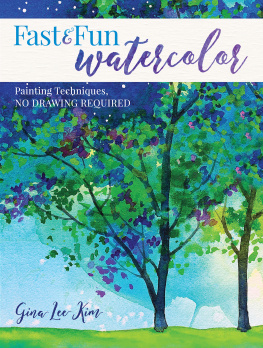Thank you for purchasing this Artist Network eBook.
Sign up for our newsletter and receive special offers, access to free content, and information on the latest new releases and must-have art resources! Plus, receive a coupon code to use on your first purchase from NorthLightShop.com for signing up.
or visit us online to sign up at
http://artistsnetwork.com/ebook-promo
DEDICATION
This book is dedicated to my sister, Carey, who has stood by my side both literally and figuratively throughout this creative journey. I couldnt have done it without you nor would I have wanted to.
And of course to my four-legged critters that love me unconditionally and where the source of my strength resides.
Contents
WHAT YOU NEED
eraser
hair dryer
liquid frisket
magnifying glass
paintbrushes
palette
paper towels
pencils
pencil sharpener
reference images
rubber cement pickup
salt
sketchbook or journal
sponge
spray bottle with water
straightedge/ruler
water container
watercolor paint
watercolor paper
watercolor pencils
waterproof ink
water-soluble pastels
water-soluble pencils
water-soluble pens
Introduction
UNTIL ONE HAS LOVED AN ANIMAL A PART OF ONES SOUL REMAINS UNAWAKENED. ANATOLE FRANCE
I am a true lover of animals. All kinds, especially those with fur and feathers, steal my heart. I grew up with dogs, cats, mice, guinea pigs, rabbits, chickens, goats and, my favorite, horses. Horses have been a part of my daily life since I was seven years old and continue to be a big part of my life to this day. I cannot imagine my life without them, not to mention my schnauzer and three kitties. I connect with animals in a special way that is very different from the way I do with people. I can be my true self with them. My soulful connection with them comes through in my artwork as well. The two constants in my life have always been animals and art, so it seems only fitting to write a book about just that!
Watercolor is like animals in many waysorganic, transparent and flowing, and with a mind of its own. I love the textures and patterns that watercolor naturally creates, which mimic nature itself. It is a great medium for capturing creatures both great and small.
In the following pages you will learn my easy, expressive and intuitive No Excuses watercolor techniques applied to the subject of animals. I have organized the animals field guide into three sections dedicated to paws (furry friends), claws (birds) and hooves (farm animals), which will provide everything you need to know about each beautiful creature to create soulful pieces of art.
Whether you have critters at home or connect with them out in nature, their presence in our lives has great meaning. I think youll find that when you feel strongly about an animal subject, those feelings come through on the page.

PART 1
Tools & Techniques

Critters make perfect painting subjects for water media because of their textured feathers and fur. Watercolors translucent layers create depth while the colors blend to mimic variegation in an animals coat. The addition of water-soluble crayons and pencils on top of watercolor also allows for added detail and texture.
The following section covers some of my favorite tips and techniques to help bring your creatures to life, including your supply list, how to set up your palette, basic brush techniques, color, drawing and unique time-saving tips. All the information you need to get started creating your favorite critters!
DRAWING TOOLS
Experiment with other drawing tools in your paintings and art journals. Here are a few examples to get you started:
Pencils
Both mechanical and wood pencils are available with different types of lead. I prefer to use an HB or 2B mechanical pencil with size .03 lead as it is softer, provides a lighter touch and is easy to erase. There are also several different kinds of watercolor pencils that come in a variety of colors.
Pens
There is nothing like the feel of using a pen to draw with confidence. Just make sure that it is waterproof ink. Micron 005 nibs produce a fine, soft smooth line while fountain sketch pens lend an expressive personality to an image.
Crayons
Many different types of water-soluble crayons and pastels on the market make a nice addition to watercolor work. If a crayon is broken off, use the large size of a brass pencil sharpener to sharpen it to a point.
Water-Soluble Colored Pencils
Water-soluble crayons and pastels come in a variety of colors and can be used to add words as well. Pencils allow you to add details, texture and definition. You can leave them dry our add water to soften.
Pencil Sharpener
I prefer a brass wide-barreled hand sharpener to create an ultra-fine point for my crayon. This also allows me to lengthen the life of my crayons. For colored pencils I prefer an electric or battery-operated sharpener.

Paper
Paper comes in different weights and textures (not to mention colors and shapes). I suggest buying a few small sheets of different kinds and test-driving them before you make a large purchase.
Types of textures: Hot-pressed paper has a smooth surface or little tooth. Cold-pressed paper has a textured surface. Rough paper has a highly textured surface.
Types of weights: 90-lb. (190gsm) is very lightweight paper that will buckle with water; 140-lb. (300gsm) is average-weight paper that will buckle slightly but will flatten out; 300-lb. (640gsm) is heavyweight watercolor paper that will not buckle and does not need to be stretched.

Journals and Sketchbooks
Journals can be store bought or handmade with watercolor paper. They come hardbound as well as with a spiral binding in a variety of shapes and sizes. The most important thing to pay attention to is the type and weight of the watercolor paper the journals contain. I prefer 140-lb. (300gsm) paper because it holds up well to water and paint.
Sponges
Sponges are one of my most valuable watercolor tools. I could not live without them. I buy inexpensive kitchen sponges by the dozens. They are always present by my palette for wiping off the water from my brush. They can also be cut easily with scissors to fit in a travel palette and are quickly reconstituted with a spray of water.
Spray Bottle
I always have a spray bottle filled with clean water nearby to spray down my dry watercolor palette and for adding drips and texture to my work.



